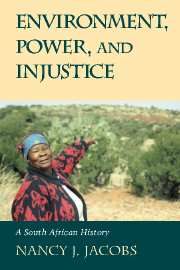Book contents
- Frontmatter
- Contents
- List of Illustrations
- List of Tables
- Preface
- Abbreviations
- 1 Approaching Kuruman
- 2 Goat People and Fish People on the Agro-Pastoral Frontier, c. 1750–1830
- 3 Intensification and Social Innovation on the Cape Frontier, 1820s–1884
- 4 Colonial Annexation: Land Alienation and Environmental Administration, 1884–1894
- 5 Environmental Trauma, Colonial Rule, and the Failure of Extensive Food Production, 1895–1903
- 6 The Environmental History of a “Labor Reservoir,” 1903–1970s
- 7 Apportioning Water, Dividing Land: Segregation, 1910–1977
- 8 Betterment and the Bophuthatswana Donkey Massacre: The Environmental Rights of Tribal Subjects, 1940s–1983
- 9 Retrospectives on Socio-Environmental History and Socio-Environmental Justice
- Appendix A South African Census Statistics on Human Population
- Appendix B South African Census Statistics on Stock Population
- Appendix C1 1991 Individual Interviews
- Appendix C2 1997–1998 Individual Interviews
- Appendix C3 1991 and 1997–1998 Group Interviews
- Appendix D A Note on Archival Sources
- Notes
- Index
9 - Retrospectives on Socio-Environmental History and Socio-Environmental Justice
Published online by Cambridge University Press: 05 July 2009
- Frontmatter
- Contents
- List of Illustrations
- List of Tables
- Preface
- Abbreviations
- 1 Approaching Kuruman
- 2 Goat People and Fish People on the Agro-Pastoral Frontier, c. 1750–1830
- 3 Intensification and Social Innovation on the Cape Frontier, 1820s–1884
- 4 Colonial Annexation: Land Alienation and Environmental Administration, 1884–1894
- 5 Environmental Trauma, Colonial Rule, and the Failure of Extensive Food Production, 1895–1903
- 6 The Environmental History of a “Labor Reservoir,” 1903–1970s
- 7 Apportioning Water, Dividing Land: Segregation, 1910–1977
- 8 Betterment and the Bophuthatswana Donkey Massacre: The Environmental Rights of Tribal Subjects, 1940s–1983
- 9 Retrospectives on Socio-Environmental History and Socio-Environmental Justice
- Appendix A South African Census Statistics on Human Population
- Appendix B South African Census Statistics on Stock Population
- Appendix C1 1991 Individual Interviews
- Appendix C2 1997–1998 Individual Interviews
- Appendix C3 1991 and 1997–1998 Group Interviews
- Appendix D A Note on Archival Sources
- Notes
- Index
Summary
Like a photographic print in the processing bath, an unrecognized history in Kuruman comes into sight when human society and the biophysical environment are mixed in the developing solution. It emerges that the quiet thornveld and quiescent people there share a complex history. For more than 200 years, people interacted in varying and changing ways with the landscape and each other. The point of this book, however, has not been to vindicate Kuruman as a scene of dynamism. More importantly, this history of the edge of the Kalahari yields new perspectives on the wider field of southern African history. We have seen that the environment is a locus of struggle between people. Moreover, the different ways people relate to biophysical conditions and processes help shape structured inequalities in society. Images developed through the socio-environmental approach to the history of Kuruman will be reflected in histories of other places – in southern Africa and in other parts of the continent. These include Bantu speakers consigned to a foraging class; agro-pastoralists who are receptive to, yet discriminating of, innovations introduced from Europe; Africans being transformed into colonial subjects through environmental processes; migrant workers who herd and garden; and an environmentally interventionist state acting on the food production of the colonized.
As a retrospective on the larger meanings suggested by a socio-environmental study of Kuruman, I will comment on several points it raises about the interpretation of South African rural history.
- Type
- Chapter
- Information
- Environment, Power, and InjusticeA South African History, pp. 206 - 222Publisher: Cambridge University PressPrint publication year: 2003

